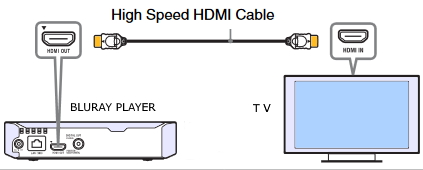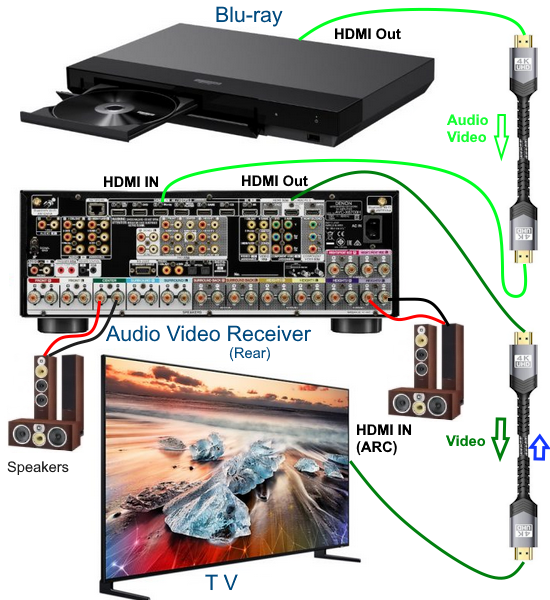
 |
| 100 Diagrams
Index Connect a Blu-ray disc Player to an Audio/Video Receiver to a TV. Netflix Bluray Players  Blu-ray disc players have undergone several changes since their introduction. Depending on which model you have, your capabilities may be higher or lower. Generally the latest models will have more capabilities. HDMI 1.3 is one example. HDMI 1.3 was generally not available on the first generation models but has been added to the later models. HDMI 1.3 allows the newer audio codecs to be passed via HDMI cable. Make sure your Audio/Video Receiver also has the same HDMI capabilities. Bluray is all about High Definition video but often overlooked is the audio available on the disc. By connecting your Bluray player directly to your HDTV you limit your sound experience to only stereo (2 channel). Your HDTV typically has no way to decode the digital audio from the movie. Soundbars with decoders built-in can decode a 6 channel bitstream but often have only 3 or 4 speakers so you are still not getting full surround sound. By connecting your Bluray player to a full-sized audio/video receiver with the latest audio decoders built-in, you are assured of getting the best audio from your Bluray movie. Bluray - Supported audio formats • Linear PCM (LPCM) - offers up to 8 channels of uncompressed audio. • Dolby Digital (DD) - format used for DVDs also known as AC3, 5.1-channel surround sound. • Dolby Digital Plus (DD+) - extension of DD, increased bitrates and 7.1-channel surround sound. • Dolby TrueHD - extension of MLP Lossless, lossless encoding of up to 8 channels of audio. • DTS Digital Surround - format used for DVDs, offers 5.1-channel surround sound. • DTS-HD - extension of DTS, offers increased bitrates and up to 8 channels of audio. What cable should I use to hookup Bluray player to HDTV? HDMI cable is recommended because HDMI can pass 1080p video and the newest audio formats such as Dolby TrueHD. A single HDMI cable from Bluray player to A/V receiver and a single HDMI cable from A/V receiver to HDTV is all you need. HDMI ARC/eARC Your Audio Video Receiver should have HDMI ARC (Audio Return Channel) for the TV connection. Use the TV HDMI ARC port. The newer eARC can handle the Dolby TrueHD audio format. The AVR will handle the decoding, amplifying and send to the correct channel while the video is sent to the TV. Components: o HDTV set. o Blu-ray disc Player. This hookup has surround sound. Look here for no surround sound hookup configuration. Why would you want this configuration? You want to play a Blu-ray High-Def disc (movie) and have a surround sound processor and you want to watch High-Def TV from your cable TV provider. What can you do with this configuration? o Play a Blu-ray disc and watch on HDTV o Watch TV and HDTV shows. o Listen to surround sound audio Audio is via the Audio/Video Receiver loudspeakers.  Blu-ray Player directly to TV, no surround sound  Blu-ray Player to AVR or soundbar and out to TV, surround sound  I have an older AV Receiver without HDMI. How do I connect for surround sound? Use the Coaxial (or Optical) audio hookup.  To Use:
Surround Sound: Blu-ray disc is not just High Definition video. The audio has also been upgraded to higher quality. Dolby TrueHD is one of the audio codecs which can be encoded on the audio tracks on a Blu-ray disc movie. What do I need in order to enjoy the new surround sound Blu-ray can offer? 1) The Blu-ray disc has to contain the newer higher resolution surround sound audio. Some movies still rely on Dolby Digital 5.1 2) Your Blu-ray player must have the capability to decode the new audio or be able to pass-thru the audio for processing by another device. If the player can decode the audio, you can use the RCA analog audio cables from the player to the A/V Receiver. Depending on your player and A/V Receiver, you may use 5.1, 6.1 or 7.1 connections. In order to use the HDMI cable to pass the new audio thru to the A/V Receiver, you must have HDMI version 1.3 capability. HDMI 1.3 Released June 2006. * Increases single-link bandwidth to 340 MHz (10.2 Gbps) * Optionally supports 30-bit, 36-bit, and 48-bit xvYCC with Deep Color or over one billion colors, up from 24-bit sRGB or YCbCr in previous versions. * Incorporates automatic audio syncing (lip sync) capability. * Supports output of Dolby TrueHD and DTS-HD Master Audio streams for external decoding by AV receivers. TrueHD and DTS-HD are lossless audio codec formats used on HD DVDs and Blu-ray Discs. If the disc player can decode these streams into uncompressed audio, then HDMI 1.3 is not necessary, as all versions of HDMI can transport uncompressed audio. Note: Blu-ray players typically have HDMI output, however it is important to understand the version of HDMI your player has, since HDMI has undergone many enhancements since inception. HDMI version 1.0, 1.1, 1.2 and 1.3 have certain capabilities which may limit your level of performance. See HDMI Versions for more information.  A/V Receiver rear panel surround sound loudspeaker connections The optical (Toslink) and the SPDIF coaxial digital audio connection cannot pass the newer audio bitstreams such as Dolby TrueHD because of bandwidth limitations. They can only pass the audio bitstreams such as Dolby Digital 5.1 or equivalents for decoding. Learn about Surround Sound and Blu-ray disc • Sony Blu-ray Players Columbia ISA - Empowering consumers thru information. • See over 100 Hookup Diagrams Internet and Bluray The newest Bluray players have the ability to connect to your broadband internet service so that you can download movies directly from online movie providers such as Netflix and view them on your HDTV. With the proper setup and services, you can get your movies online and reduce the trips to the store to buy Bluray movies or standard DVD movies. • Bluray players and internet hookup • Bluray net-ready internet players, Netflix Can I hookup my Bluray player to my older analog TV? Yes, connect the yellow video output on the Bluray player to your analog TV yellow video input. For sound, connect the white and red analog audio outputs on the Bluray player to the white and red audio inputs on your TV. Select the input on the TV matching the Bluray connections. For players with only HDMI out, you need to buy a converter, HDMI to RCA AV and then connect to TV. What if my TV has no A/V inputs, only a RF input jack? You can use an RF modulator. Connect the yellow, white and red RCA cables from Bluray to RF modulator and a coaxial cable from RF modulator to TV. Select channel 3 (or 4) on the TV. • RF modulator hookup |